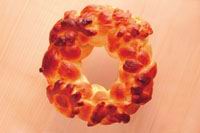Rastislava Stoličná
Ritual bread played a significant role in the context of family and annual ceremonies. The origin of such pastry is sought in basic human food – bread. In all agricultural civilization cultures, bread prepared at feast time symbolizes a desire for fertile fields, family richness and generally home and goodness. Its round shape is the simplest and most perfect picture symbolizing the sun – the life-giving element of the Earth. A circle also symbolizes the life of man, from birth to death; it is also a symbol of infiniteness, eternity, perfection, and God. Similar cultural and semantic symbols can be found with cake in the folk tradition. The oldest form of traditional ritual bread in Eastern Slovakia was kračun Christmas bread. The dough was enriched with various ingredients: grain seeds, legumes, flax, which in the sense of magic was supposed to ensure good crops. Magic powers were added by garlic, and parsley chives as symbols of health and protection against bad powers. In eastern Slovakia, a variety of figural breads were also prepared at Christmas. Birds were intended for Christmas carol signers. In western Slovakia, a small pastry in the shape of a bird was given to children at Easter on Palm Sunday or at weddings. A wedding is a family feast where the traditional symbolic performance and food was preserved the longest. According to folk belief, it was intended to ensure prosperity, fertility and happiness for the newlyweds. Traditional folk pastry used basic shapes: circular, horseshoe, square or rectangular. Often they were decorated with a plat of dough or other decorations made from dough or paper. In prosperous areas it was common to bake the main wedding cake from large shapes. At the end of the wedding celebration, the cake was cut up and given to the wedding participants as proof of their attendance. This custom slowly evolved into the tradition of giving something after the wedding, which still remains alive today.
